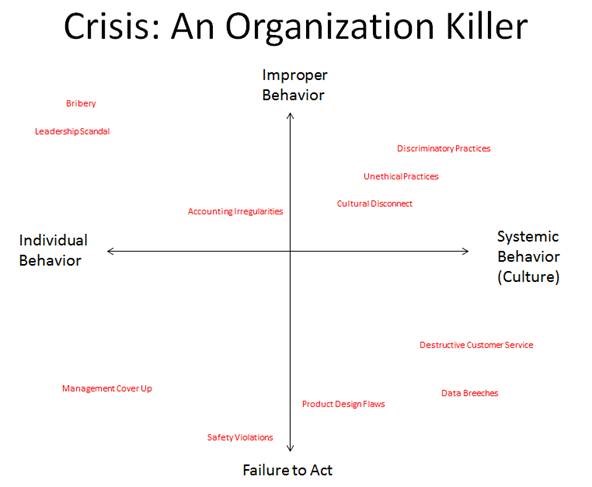 “Who could have known?”
“Who could have known?”
“That one surprised us all.”
When it comes to corporate crises, we hear these statements all too frequently. But should we?
Contrary to general opinion, most corporate crises are entirely predictable. We may not know the actors or the timing, but we do know the categories. The argument that “all crises are unique” is particularly true, but broadly false. There are patterns. In fact, we can map virtually all predictable corporate crises today in two dimensions: Individual or Systemic Failure; and Sins of Commission vs. Sins of Omission.

Corporate crises today are broadly predictable. The challenge in the 21st century is that:
- We live in a VUCA world – volatile, uncertain, complex and ambiguous
- The rate of change is accelerating
- Change is becoming discontinuous with the recent past as we exit the industrial era and as the nations that powered our growth leave their demographic growth windows
These trends are unlikely to reverse. And this means that the 21st century is almost certain to be turbulent and disruptive, birthing entirely new types of corporate crises. With this in mind, Boards and executives should be asking what types of crisis events they are likely to see in the 21st century.
Is it possible to map specific 21st century crises? If not, can we clearly identify the drivers of the 21st century corporate crises? What are these turbulent megatrends? How we communicate during crises in this VUCA world is yet another challenge, and it is made all the more difficult by the historic erosion in public trust across institutions and geographies.
Next week, at the IPR Trustees Research Symposium, Robert Moran will describe how the “Top 10” megatrends will change the crises we will encounter in the future. Pulling from many sources and his work as an opinion researcher and futurist, he will analyze corporations’ exposure to these 10 megatrends. You can register for the Symposium by emailing at associate@instituteforpr.org. Our full agenda for the event can be found here.
Robert Moran is a Partner at Brunswick Insight in Washington, DC.




Would love to get a copy of the article/speech. There are some fascinating ideas here, although it’s hard to assess them with such limited info. E.g., numbers 1 & 3 regarding 21st century are not new; they’re endemic to human nature and interactions although more detail might help to differentiate them from the past.
Also, most so-called crisis experts fail to clearly and effectively define the word “crisis” and differentiate it from issues, incidents, disasters, etc. I’d be interested in the author’s definition.
Finally, while I think the chart is an excellent guide to understanding organizational behavior, I wonder if it’s truly predictive, i.e, do all all companies with discriminatory practices or data breeches, to name just two, undergo crises? If it’s the degree to which these negative practices exist, what’s the threshold point and can it be measured? I’ve always argued that crises are the result of organizational mismanagement, which is consistent with the argument presented, but it’s how one handles an event such as negative attention to discriminatory practices or a data breech that determines whether or not the organization goes into a crisis. I’m including my email so if someone could send me the article, I’d appreciate it.
Hello Mark,
Thank you for your comment and insights. I will email you a PDF version of the article. Also here is a link to the video of Robert Moran’s presentation. https://instituteforpr.org/events/trustees-research-symposium/
Hope this helps!
Best,
Sarah Jackson
PR Associate
associate@instituteforpr.org
This is a greater teaser for the presentation because as a reader I want to know more about what Robert’s ideas. I firmly agree with the idea of patterns and drivers in corporate crises. The crisis map visual shows a strong connection between this practitioner view of crises and how academics view crises. I see strong connections to academic efforts to detail the effects of crisis responsibility. It is great to see the way practitioner and academic crisis research reinforces one another.